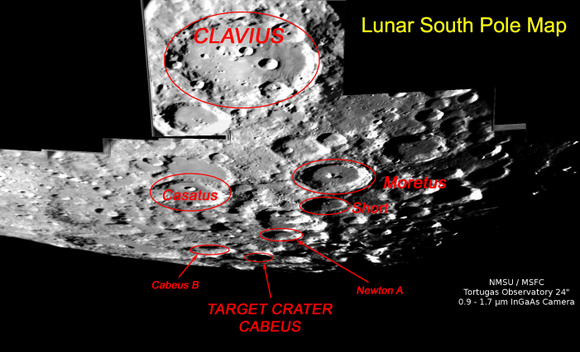Tomorrow (Friday, Oct 9) at 7:31:19 a.m. EDT and 7:35:45 a.m, Centaur and LCROSS spacecraft (Lunar Crater Observation and Sensing Satellite) will search for water ice on the Moon by making two impacts into the moon’s Cabeus crater at the lunar South Pole. And YOU can watch this unfold. Here’s all you need to know about this “not to be missed” event, from Universe Today:
“Guide to Seeing the LCROSS Lunar Impact”
Written by Nancy Atkinson
The LCROSS spacecraft is going to impact the Moon on Friday, October 9, and here’s your chance to watch the action, either just for fun, or to contribute to scientific observations. Whether you want to observe with your own equipment or watch the event on television or a webcast, below you’ll find all the information and links you should need to be a part of history. Amateur astronomers need a 10-inch or bigger telescope to make observations.
The LCROSS mission is going sending a upper stage of a Centaur rocket and a smaller spacecraft to impact the Moon. The two objects will create a crater — The 5,000-pound (2,270-kilogram) Centaur is expected to slam into Cabeus Crater on the Moon’s south pole at a sharp angle at a speed of 5,600 mph (9,000 kilometers per hour). The Centaur’s collision is expected to create a crater roughly 60 or 70 feet wide (20 meters wide) and perhaps as much as 16 feet (5 meters) deep, ejecting approximately 385 tons of lunar dust and soil — and hopefully some ice.
The LCROSS spacecraft itself, weighing in at 1,500-pounds (700-kilograms), will follow the Centaur by about four minutes and fly through the regolith plume thrown up by the collision, just before it too slams into the lunar surface, kicking up its own smaller plume of debris, all the while using its sensors to look for telltale signs of water, beaming the information back to Earth.
So, yes, it will make a rather big crater on the Moon.

